Sewer Pipeline
Year: 2020 - 2022
Author: Murthy Kadiyala, PE
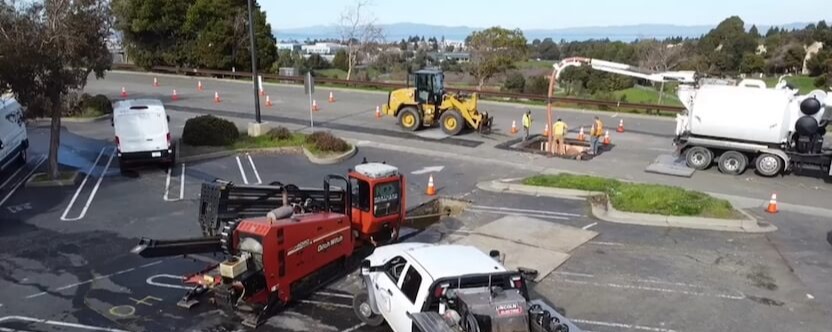
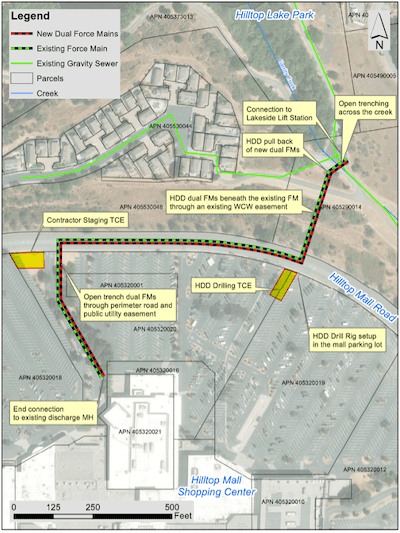
The Client shared a vision of robust reliability and expedited schedule for replacing the Lakeside force main in its entirety. To the engineers at LEE + RO, this meant specifying corrosion-resistant pipe material as well as designing a dual FM. The design also called for horizontal directional drilling (HDD) for the installation within the brush-covered hillside terrain. HDD allows for a significant reduction in the construction duration and avoids environmental mitigation by not having to disturb the ground surface from trenching activities compared with open trench methods.
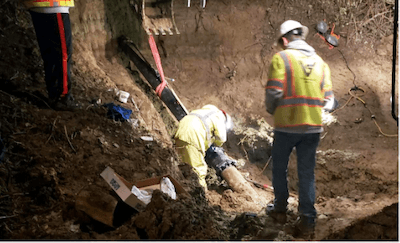
The 45-year-old, 8-inch ductile iron FM at the Lakeside Lift Station carries pumped flow to a manhole at 500 gpm and 120 ft of TDH. The first 300 LF of the FM is through brush-covered hillside terrain sloping up to the Hilltop shopping mall. The remaining 1,300 LF of the alignment follows the right-of-way (ROW) around the shopping mall through a common utility trench in the parking lot which terminates at an existing gravity sewer discharge manhole.
The existing primary sewer force main for Lakeside Lift Station, which was installed in 1977 and made up of 8-inch ductile iron pipe (DIP), was found to be leaking in April 2020 and was spot repaired with 18 LF of ductile iron pipe. Soon after the completion of emergency repairs on the existing Lakeside Force Main, the Client sought a proposal and awarded a design contract to LEE + RO for designing a new secondary force main, which provides redundancy and allow the primary force main to be shut down and maintained periodically.
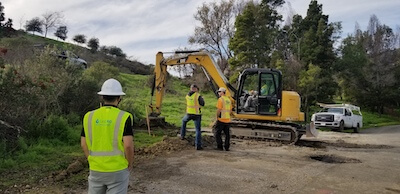
Early in the design process, the Client decided to responsibly build resiliency into the system by completely replacing the existing force main with new dual force mains at a nominal cost adder. LEE + RO researched and identified an alignment and a utility corridor that could accommodate the dual force mains in the same trench. The dual force mains were fitted with mainline cleanouts that serve as access gateways into the pipeline for periodic cleaning and CCTV investigation.
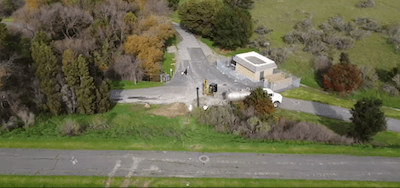
The Client embraces technologies that promotes its role as a community citizen in creating clean, safe water for release into the San Francisco Bay. One such technology that the Client has successfully employed is the trenchless method of installing pipeline called Horizontal Directional Drilling (HDD). The steep hillside along the first 300 LF of the force main alignment from Lakeside Lift Station was an ideal application for HDD. The remaining 1,300 LF of the force main alignment along the perimeter road around Hilltop Mall, and through the public utility easement that leads into the mall, was best suited for open trench construction, with minimal construction impacts.
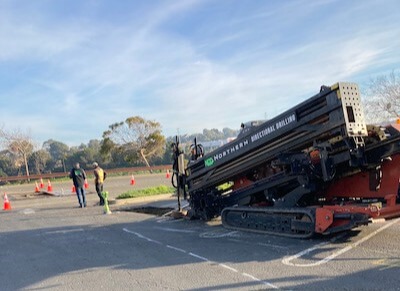
Pilot Hole - The Horizontal Directional Drilling (HDD) process begins with boring a small, horizontal hole (pilot hole or drill path) with a continuous string of steel drill rod. The bore head is tracked electronically guiding the hole to the opposite end. As large a radius of curvature is utilized to minimize curvature along the drill path which induces bending stresses and increases the pullback load. Carefully selecting the entry and exit points and curvature of the drill road and pipe is key to minimizing tensile stresses and maximizing the collapse resistance.
The first step in planning HDD for the hillside section of this project was the HDD layout. There was adequate room at both ends to support HDD operations, however easements were required. With the help of LEE + RO, the Client negotiated temporary construction easements (TCE) with the mall owner. After several HDD layout and easement iterations, the contractor ended up setting up the HDD drill rig in the mall parking lot, requiring a TCE area measuring 100 LF long by 40 LF wide. The entry bore pit in Hilltop Mall Road was approximately 10’ x 10’ by depth depending on the angle of entry from the HDD drill rig. A secondary containment ditch 3’ x 10’ was created to contain the drilling mud.
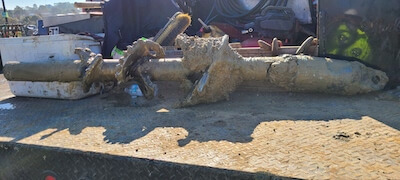
Reaming - When the bore head and rod emerge on the opposite end, a special cutter, called a back reamer, is attached, and pulled back through the pilot hole to a slightly larger diameter than the carrier pipeline. The percentage oversize depends on soil types, stability, depth, drilling mud, borehole hydrostatic pressure, etc. While over-sizing is necessary for insertion, it means the inserted pipe will have to sustain vertical earth pressures without significant side support from the surrounding soil. The drilling mud such as fluid bentonite clay reduces drilling torque and gives stability and support to the bored hole. The fluid must have sufficient gel strength to keep cuttings suspended, to form a filter cake on the borehole wall, and to provide lubrication between the pipe and the borehole on pullback. Cementitious agents are typically added to make the thickened drilling mud stiffer than the soil.
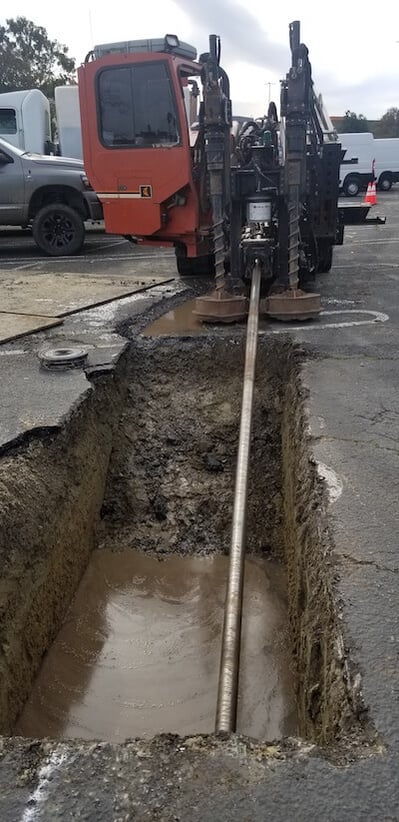
Pullback - The pullback operation involves pulling the entire pipeline length in one long fused HDPE pipe segment, back through the drilling mud along the reamed-hole pathway. Proper pipe handling, cradling, bending minimization, surface inspection, and fusion welding procedures must be followed.
Using the Client’s past knowledge of the soils in the vicinity, including successfully completed HDD projects, it was decided to have the contractor and the drilling sub-contractor self-perform the necessary geotechnical investigation for HDD feasibility in the area. Site-specific challenges include a vertical drop of nearly 90 feet from end to end of the HDD, which is more than typically encountered in HDD projects. The HDD layout with the HDD drill rig at the top also enabled gravity to assist with the drilling mud during the pilot hole boring. The drill rig was appropriately sized for the anticipated pullback loads taking into account the elevation difference between the ends. LEE + RO selected a 10-inch diameter HDPE DR11 (8.68’’ ID) pipe that met not just the hydraulic requirements but also met the pullback and external service loads. Due to the mostly fill soils in the area that made up the Hilltop Mall, groundwater was not encountered
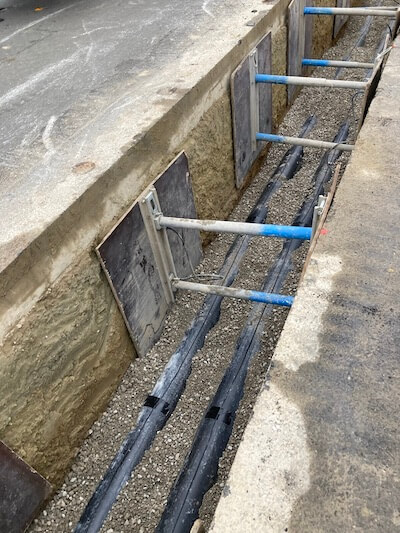
LEE + RO designed an alignment where there was adequate room for a 4-foot wide by 5-ft deep trench in which the dual force mains were installed. The pipes were bedded in crushed rock, after the HDPE pipes and the locator wires were placed 1-foot clear in the trench. The pipes were conveniently fused above ground prior to placing in the open trench. LEE + RO obtained utility maps from the Client, City of Richmond, EBMUD, PG&E and AT&T. The contractor performed utility potholing ahead of the trenching to minimize field conflicts. Field traffic control followed WATCH Manual and MUTCD requirements. The alignment passing through the perimeter road with multiple entries to the mall greatly mitigated the traffic impacts.
Due to crowded utilities in the public utility easement and in keeping with the 10-foot separation requirement from potable water mains, the alignment was revised during construction to cut through the planter area, and the curb and gutter were later reconstructed and the surface restored upon completion of construction.
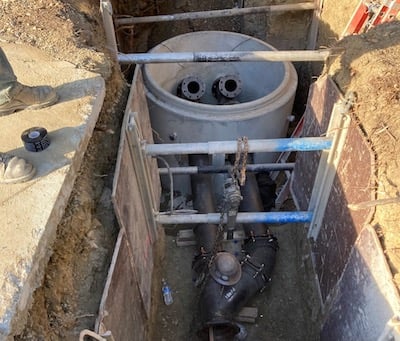
Most construction was completed without the need for any temporary bypassing, as the existing force main continued to be in service. At the discharge manhole, a new internal drop connection was constructed inside the existing manhole. The HDPE dual force mains transitioned into a new cleanout manhole using ductile iron spools and merged into a single wye connection prior to connecting to the existing discharge manhole.
The tie-in connection at the Lakeside Lift Station was performed during a night time shutdown window. The Client ensured the Emergency Response Plan was in place prior to the tie-in which primarily consisted of a back-up Baker tank and pumper trucks as needed. The Lakeside Lift Station previously underwent upgrades that include a new cleanout connection inside a surge relief vault, that was used for the pumper trucks to connect to for bypassing the flows. A couple of 48-inch diameter manholes were installed at the end of HDD portion, which housed new motor-operated plug valves that were wired for power and controls to the lift station. The dual force mains subsequently merged into a wye connection using new ductile iron pipe spools and fittings prior to connecting to the existing 8-inch diameter ductile iron force main just outside of the lift station.
Despite working through a time crunch amid costly repairs of failing sewer force mains, the Client pushed through with an unwavering commitment towards responsible resiliency in completing construction of new dual force mains for Lakeside Lift Station in June 2022, which is slightly more than two years from planning to completion.
The stakes were high due to the location of the project near a creek and nearby residents with high consequences of failure but LEE + RO facilitated a design based on due diligence and industry standard practices, with a clear delineation of the contractor’s responsibilities in the contract documents. The Client selected Ecast Engineering as the construction contractor after advertisement and bidding. In spite of challenges with supply chain disruptions due to the pandemic, the contractor successfully completed the project on time and within the allocated project budget at slightly over $1.1 million. Northern Drilling was the drilling sub-contractor who smoothly navigated the HDD portion of the construction.